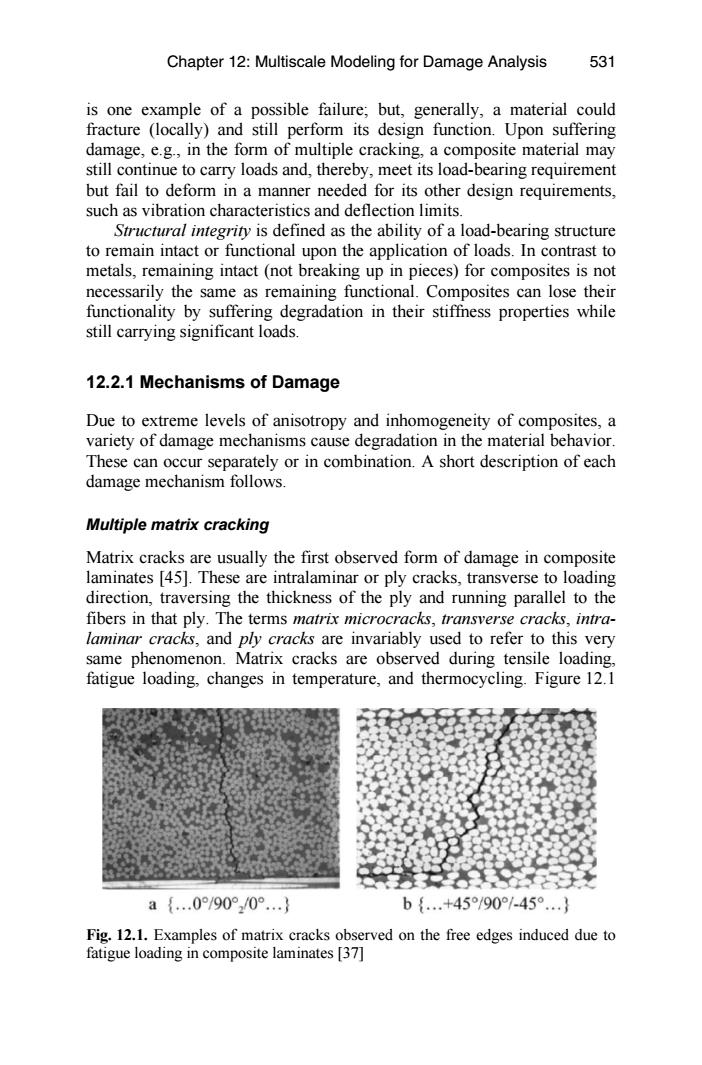正在加载图片...

Chapter 12:Multiscale Modeling for Damage Analysis 531 is one example of a possible failure;but,generally,a material could fracture (locally)and still perform its design function.Upon suffering damage,e.g.,in the form of multiple cracking,a composite material may still continue to carry loads and,thereby,meet its load-bearing requirement but fail to deform in a manner needed for its other design requirements, such as vibration characteristics and deflection limits. Structural integriry is defined as the ability of a load-bearing structure to remain intact or functional upon the application of loads.In contrast to metals,remaining intact(not breaking up in pieces)for composites is not necessarily the same as remaining functional.Composites can lose their functionality by suffering degradation in their stiffness properties while still carrying significant loads. 12.2.1 Mechanisms of Damage Due to extreme levels of anisotropy and inhomogeneity of composites,a variety of damage mechanisms cause degradation in the material behavior. These can occur separately or in combination.A short description of each damage mechanism follows. Multiple matrix cracking Matrix cracks are usually the first observed form of damage in composite laminates [45].These are intralaminar or ply cracks,transverse to loading direction,traversing the thickness of the ply and running parallel to the fibers in that ply.The terms matrix microcracks,transverse cracks,intra- laminar cracks,and ply cracks are invariably used to refer to this very same phenomenon.Matrix cracks are observed during tensile loading, fatigue loading,changes in temperature,and thermocycling.Figure 12.1 a{.0°/90°/0°..} b{..+45/90°-45°.} Fig.12.1.Examples of matrix cracks observed on the free edges induced due to fatigue loading in composite laminates [37]is one example of a possible failure; but, generally, a material could fracture (locally) and still perform its design function. Upon suffering damage, e.g., in the form of multiple cracking, a composite material may still continue to carry loads and, thereby, meet its load-bearing requirement but fail to deform in a manner needed for its other design requirements, such as vibration characteristics and deflection limits. Structural integrity is defined as the ability of a load-bearing structure to remain intact or functional upon the application of loads. In contrast to metals, remaining intact (not breaking up in pieces) for composites is not necessarily the same as remaining functional. Composites can lose their functionality by suffering degradation in their stiffness properties while still carrying significant loads. 12.2.1 Mechanisms of Damage Due to extreme levels of anisotropy and inhomogeneity of composites, a variety of damage mechanisms cause degradation in the material behavior. These can occur separately or in combination. A short description of each damage mechanism follows. Multiple matrix cracking Matrix cracks are usually the first observed form of damage in composite laminates [45]. These are intralaminar or ply cracks, transverse to loading direction, traversing the thickness of the ply and running parallel to the fibers in that ply. The terms matrix microcracks, transverse cracks, intralaminar cracks, and ply cracks are invariably used to refer to this very same phenomenon. Matrix cracks are observed during tensile loading, fatigue loading, changes in temperature, and thermocycling. Figure 12.1 Fig. 12.1. Examples of matrix cracks observed on the free edges induced due to fatigue loading in composite laminates [37] Chapter 12: Multiscale Modeling for Damage Analysis 531